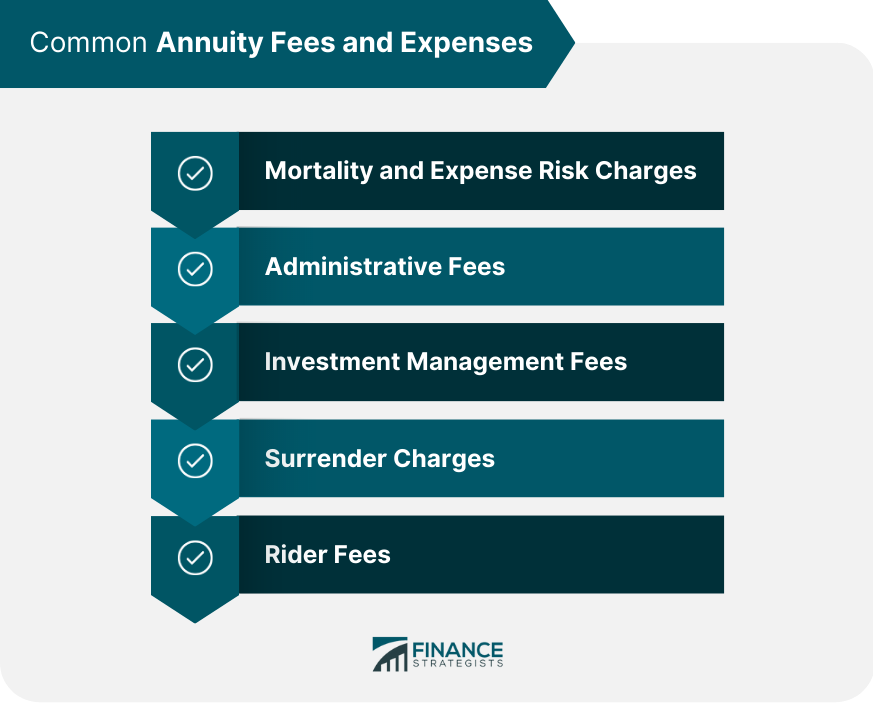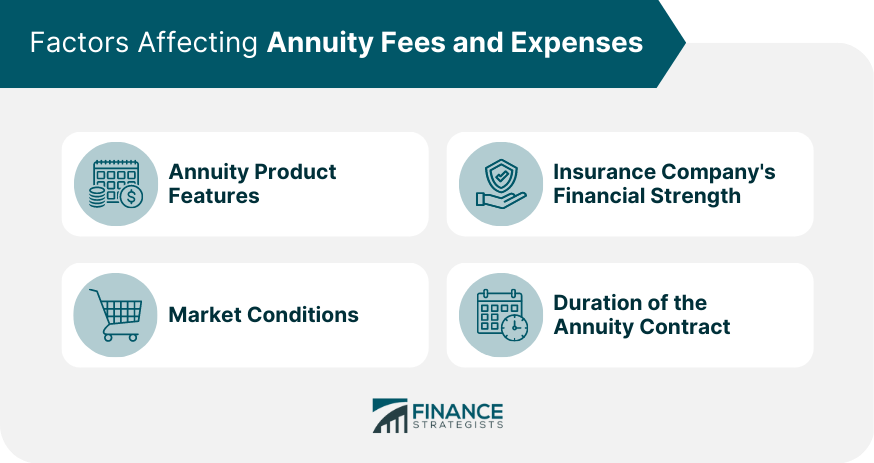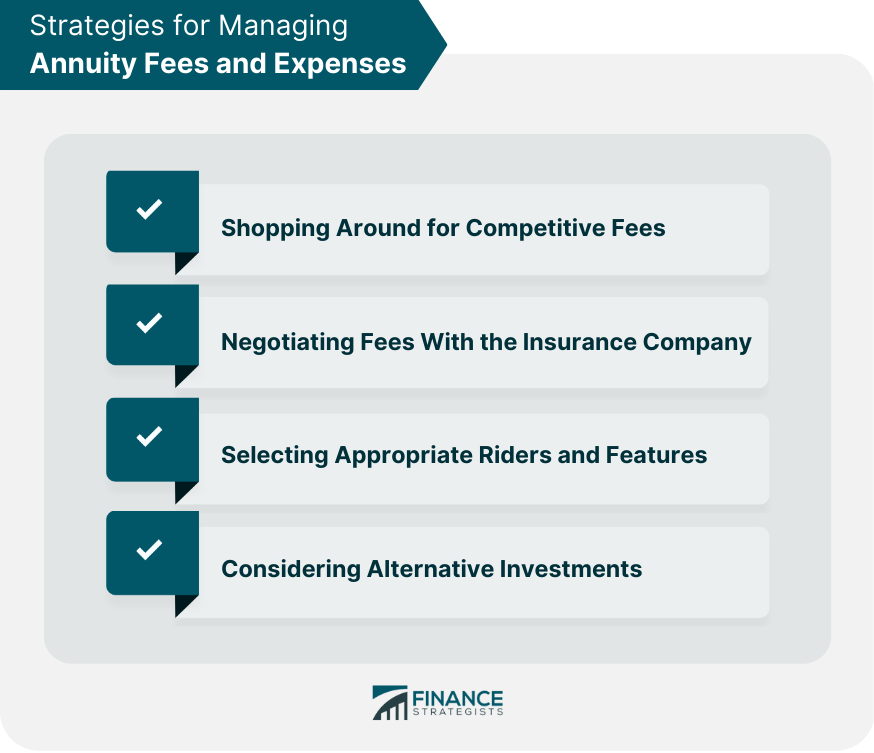Annuity fees and expenses are the costs associated with purchasing and owning an annuity. These fees can include mortality and expense risk charges, administrative fees, investment management fees, surrender charges, and rider fees, among others. Understanding these fees is crucial for evaluating the long-term performance of annuity products and making informed decisions in your financial planning. Understanding annuities' various fees and expenses is crucial when comparing products and assessing their impact on your long-term financial goals. Annuities can have a variety of fees and expenses, including mortality and expense risk charges, administrative fees, investment management fees, surrender charges, and rider fees. High fees can significantly reduce the overall returns on your annuity investment, making comparing costs across different products essential. When evaluating annuity products, it is essential to consider the potential returns and the fees and expenses associated with each option. These fees cover the insurance company's costs for providing a guaranteed death benefit and the risk of guaranteeing annuity payments for life. These fees cover the insurance company's operational costs, such as recordkeeping, customer service, and account maintenance. Variable and indexed annuities typically have fees associated with managing the underlying investments within the annuity's sub-accounts. These fees are applied if you withdraw funds from the annuity before a specified period, typically within the contract's first 5 to 10 years. Additional optional features, such as guaranteed income riders or long-term care riders, can be added to an annuity contract for an extra fee. Complex annuity products, by nature, come with an extensive range of features and benefits designed to cater to various investment objectives and risk appetites. The added complexity and customization of these products necessitates the involvement of more resources, such as actuarial expertise and risk management techniques, which in turn leads to higher fees for the investor. Due to their straightforward nature and lower inherent risks, simpler annuity products require fewer resources to manage and maintain, resulting in lower fees compared to their more complex counterparts. The financial stability of the insurance company providing the annuity is a crucial factor that can significantly impact the fees charged to investors. Insurance companies with robust financial health are typically in a better position to manage the risks associated with annuities, enabling them to offer more competitive pricing structures for their products. In order to ensure their ability to fulfill their obligations to policyholders, insurance companies with weaker financials may be compelled to charge higher fees to offset their increased exposure to risk. Prevailing market conditions play a significant role in shaping the fees and expenses associated with variable and indexed annuities. During periods of market stability and growth, insurance companies may experience increased investment returns, which can contribute to a more favorable pricing environment for annuity products. Conversely, during periods of market volatility or decline, insurance companies strive to compensate for lower investment returns and maintain their financial stability. In such situations, the fees and expenses associated with variable and indexed annuities may increase. Longer contract durations in annuity products can be advantageous for both investors and insurance companies, as they allow for the spreading out of costs over a more extended period. The extended time horizon provides an opportunity for the insurance company to amortize various costs, such as sales commissions, administrative expenses, and other charges, over the entire life of the contract. This results in lower annual fees, making the annuity product more cost-effective and potentially more attractive to investors seeking a long-term investment strategy. Insurance companies must adhere to specific regulatory requirements regarding fee disclosures, ensuring that potential investors fully understand the costs associated with annuity products. Annuity contracts and prospectuses typically include detailed information about the fees and expenses associated with the product. Make sure to review these documents before investing thoroughly. Understanding an annuity's fee structure is essential to accurately assess the product's suitability for your financial goals and compare it with other investment options. Comparing annuity products from different insurance companies is an essential step for investors looking to maximize the value of their investments while minimizing costs. By evaluating various offerings in the market, investors can gain a better understanding of the range of fee structures available for the specific features they desire. This comparison process enables them to identify the most competitive pricing options, taking into account factors such as management fees, administrative charges, and other expenses that may be associated with the chosen annuity product. In some cases, insurance companies may be open to negotiating lower fees for annuity products, particularly when an investor is bringing in a substantial sum or purchasing multiple annuity products. When a significant investment is made, it represents a considerable inflow of capital for the insurance company, providing them with additional resources to invest and manage. This increased capital enables the company to benefit from economies of scale and potentially generate higher returns, which can translate into a more favorable pricing structure for the investor. When selecting an annuity product, it is crucial for investors to carefully consider which riders and features are truly necessary for their specific financial needs. Annuities often come with a variety of optional add-ons and provisions, such as living benefit riders, death benefit riders, or long-term care riders, all of which are designed to provide additional protection and customization to the policyholder. While these features can be beneficial in certain situations, adding unnecessary options can lead to increased fees, ultimately reducing the overall returns on the investment. Before investing in an annuity, it is important for investors to evaluate other investment options, such as mutual funds, stocks, and bonds, to determine if they may provide similar benefits with lower fees. While annuities can offer valuable features, such as guaranteed income and tax-deferred growth, they may also come with higher fees compared to other investment vehicles. By exploring alternative investment options, investors can gain a comprehensive understanding of the various opportunities available in the market, allowing them to make more informed decisions and potentially optimize their financial portfolio. Annuity fees and expenses can significantly impact your investment returns and long-term financial goals. Understanding the various fees associated with annuity products, comparing costs across different options, and employing strategies to manage fees effectively are crucial. Doing so can maximize your investment returns and secure a stable income during retirement. If you need help navigating the complexities of annuity products, consider hiring an insurance broker. They can provide personalized advice and help you make informed decisions that align with your financial goals. What Are Annuity Fees and Expenses?
Annuity Fees and Expenses Overview
Common Annuity Fees and Expenses
Mortality and Expense Risk Charges
Administrative Fees
Investment Management Fees
Surrender Charges
Rider Fees

Factors Affecting Annuity Fees and Expenses
Annuity Product Features
Insurance Company's Financial Strength
Market Conditions
Duration of the Annuity Contract

Fee Disclosure and Transparency
Regulatory Requirements
Fee Disclosure Documents
Importance of Reading and Understanding Fee Disclosures
Strategies for Managing Annuity Fees and Expenses
Shopping Around for Competitive Fees
Negotiating Fees With the Insurance Company
Selecting Appropriate Riders and Features
Considering Alternative Investments

Final Thoughts
Annuity Fees and Expenses FAQs
Annuity fees and expenses are costs associated with owning an annuity, such as mortality and expense risk charges, administrative fees, investment management fees, surrender charges, and rider fees.
High fees can significantly reduce the overall returns on your annuity investment, making comparing costs across different products essential.
In some cases, you may be able to negotiate lower fees with the insurance company, particularly if you are investing a substantial sum or purchasing multiple annuity products.
You can manage annuity fees and expenses by shopping around for competitive fees, negotiating fees with the insurance company, selecting appropriate riders and features, and considering alternative investments.
Understanding annuity fees and expenses is crucial for evaluating the long-term performance of these financial products and making informed decisions in your financial planning.
True Tamplin is a published author, public speaker, CEO of UpDigital, and founder of Finance Strategists.
True is a Certified Educator in Personal Finance (CEPF®), author of The Handy Financial Ratios Guide, a member of the Society for Advancing Business Editing and Writing, contributes to his financial education site, Finance Strategists, and has spoken to various financial communities such as the CFA Institute, as well as university students like his Alma mater, Biola University, where he received a bachelor of science in business and data analytics.
To learn more about True, visit his personal website or view his author profiles on Amazon, Nasdaq and Forbes.











